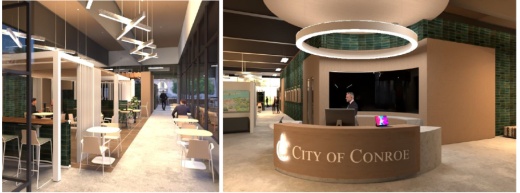The first floor has been vacant since staff moved to the Conroe Municipal Services Center, formerly used by the Conroe Police Department. Staff moved in July to have more space to work, according to Robinson.
Potential ideas presented for the vacant space include a visitor’s center with a gift shop, dining and seating areas, lounge areas open to the public and conference rooms available to rent, according to the Jan. 26 presentation. On the outside of the building, there are plans to refinish the walkway, fix issues with planters, and add an outdoor patio and porch area, according to the presentation.
“The public comes to City Hall to participate in the civic life of the city, and we need to have a space that works,” Mayor Jody Czajkoski said in a news release from the city.
Concepts also include potential security improvements and adding a reception desk, restrooms and a catering kitchen, Johnson said.
However, some council members expressed concerns over the cost of the project, which is anticipated to total around $2.5 million, according to Johnson.
“City Hall is here to conduct city business, and I think we’re stewards of the taxpayers’ money,” Council Member Marsha Porter said during the meeting. “I’m not sure taxpayers would be in favor of having dining facilities in City Hall.”
Council members also expressed security concerns with vendors and residents being in City Hall in times of natural disaster.
“This is our operations center,” Council Member Duke Coon said during the meeting. “In times of natural disaster we use this entire building, ... so security is going to be really important, whatever we do here.”
Although plans will likely not be finalized for a year, according to Robinson, initial concepts aim to create an opportunity to give the public some access to the City Hall building.
“We think that taxpayers have expectations that our public facilities should be functional and should be accessible, and when I see what is going on in other cities, I think we’re on the right track,” Robinson said.





